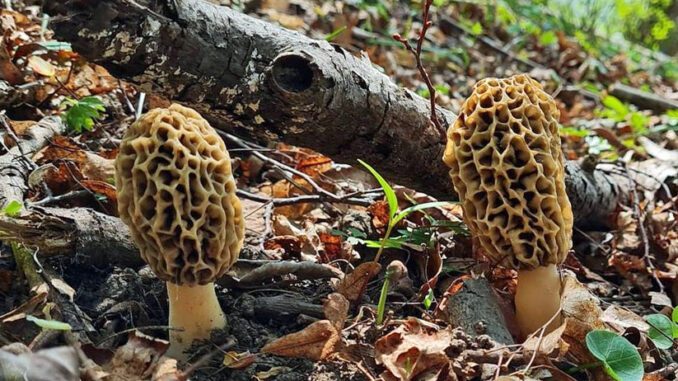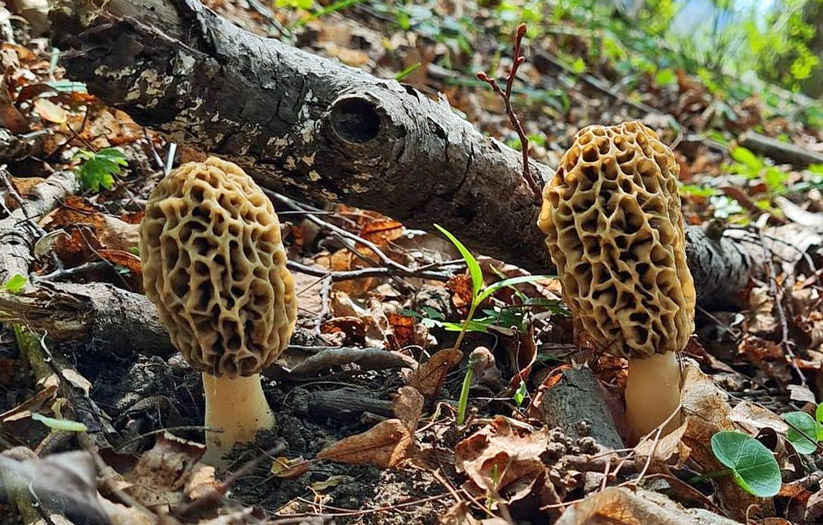
Discover the most interesting trees to find morel mushrooms!
Let’s go!

Morel Mushrooms Tree Association
First of all, you should know that there are 2 main types of relationship between morel mushrooms and trees:
- Saprophytic morels: you can’t really talk about a relationship in the sense that the morel does not associate with the roots of a tree. However, these morels, like any saprophytic fungus, play a very important role in the degradation of dead organic matter. These morels therefore develop spontaneously without the need for a tree. For example, we can cite the case of Morchella importuna which can develop on a recently modified environment (e.g. wood chips). Places with morel mushrooms of this type are not perennial.
- Symbiotic morels: the morel associates itself with the roots of a tree, establishing a lasting relationship between the morel and its host tree. An exchange of minerals and nutrients occurs to the benefit of both the tree and the morel. It is this specific type of morel that is of interest to us in this article.
What Trees Do Morel Mushrooms Grow Under?
We frequently find them in the company of numerous trees. Nevertheless, for optimal results, we highly recommend focusing on a select few trees! Additionally, you’ll observe that the white/yellow morel often forms partnerships with deciduous trees, whereas the black morel tends to associate itself with conifers. You can also find these two types of morels featured on our Mushroom Maps. Discover just below the trees beneath which morel mushrooms tend to flourish preferentially:
Hardwood
- Ash
- Aspen
- Maple
- Apple tree
- Elm
- Hazel tree
- …
Conifers
- Spruce
- Fir
- Larch
- Pine
- …
The Suitable Trees For Each Species Of Morel
If you would like even more detailed information about the association of each morel species with its corresponding list of host trees, here are further details:
The Common Morel
- M. americana:
- Ash, Elm, Aspens, Sycamores, Balsam poplars, Apple, Cherry, Pear
Yellow Morels
- M. cryptica:
- Ash
- Elm
- Tulip
- Apple trees
- M. virginiana:
- Tulip trees
- M. diminutiva:
- Ash
- Hickory
- Oak
- Tulip trees
- M. prava:
- Oak trees
- Pine trees
Black Morels
- M. angusticeps:
- White and green ash
- Cherry
- Aspen
- Tulip trees
- M. septentrionalis:
- Big-toothed aspen trees
- Ash trees
- Other hardwoods
- M. brunnea:
- Hardwood trees (oak, Pacific Madrone)
- Conifer trees
- M. importuna (saprophytic species)
- Gardens, planters, landscaped sites
- M. snyderi:
- Ponderosa pine
- White fir
- Douglas fir
- M. frustrata:
- Hardwoods (oak, Pacific Madrone)
- Conifers (sugar pine, white fir, Douglas fir, ponderosa pine)
Find Morel Mushroom With Our Maps
The data we presented to you above is not always easy to put into motion when it comes to applying it in the field. Moreover, the search for morels is more complex than the use of trees. Indeed, the nature of the soil, the elevation, and other parameters are to be taken into account. For this reason, we have created interactive maps that let you know directly where the best conditions are in your state to find morels. Explore our Morel Mushroom Maps here!
Congratulations, you have reached the end of the article! You now know more than most morel pickers about the relationship between trees and morels. If you want to expand your knowledge on the subject a little more, check out our most complete article on where to find morels.
Leave a Reply